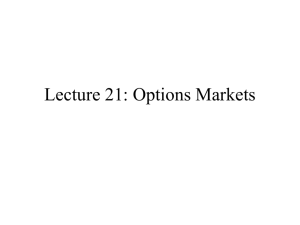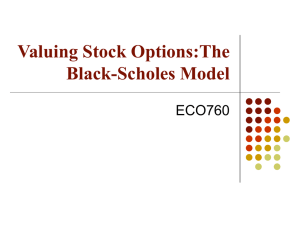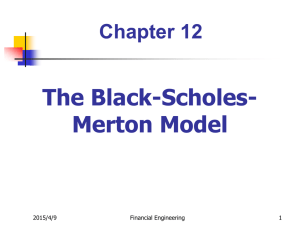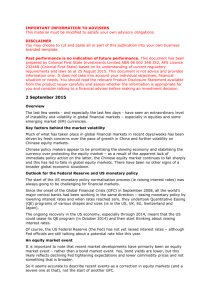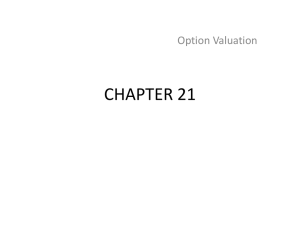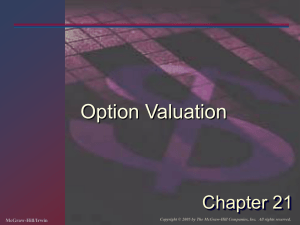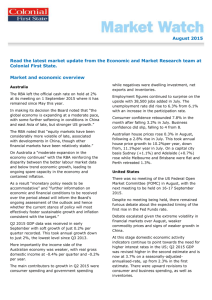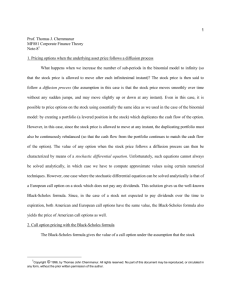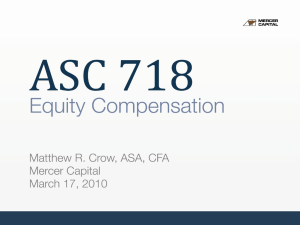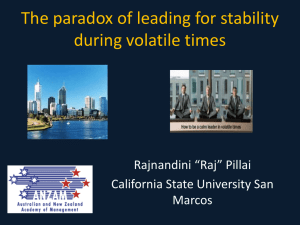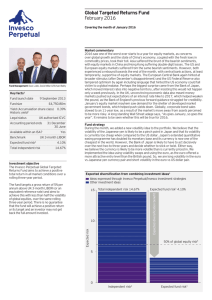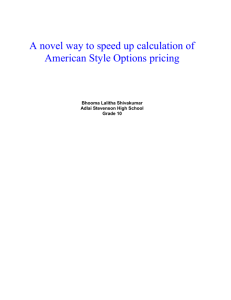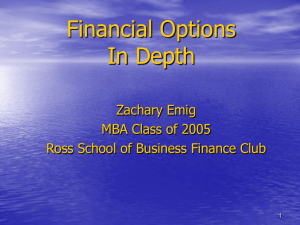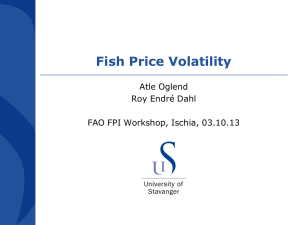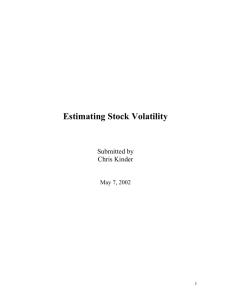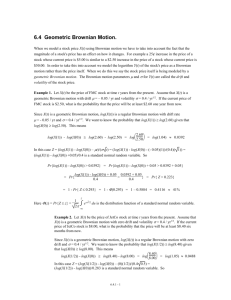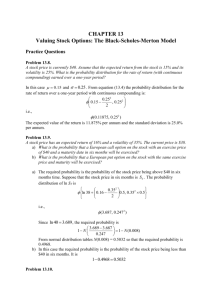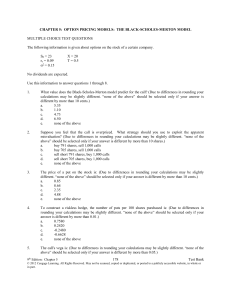Lecture Notes 16 - University of Illinois at Urbana
advertisement
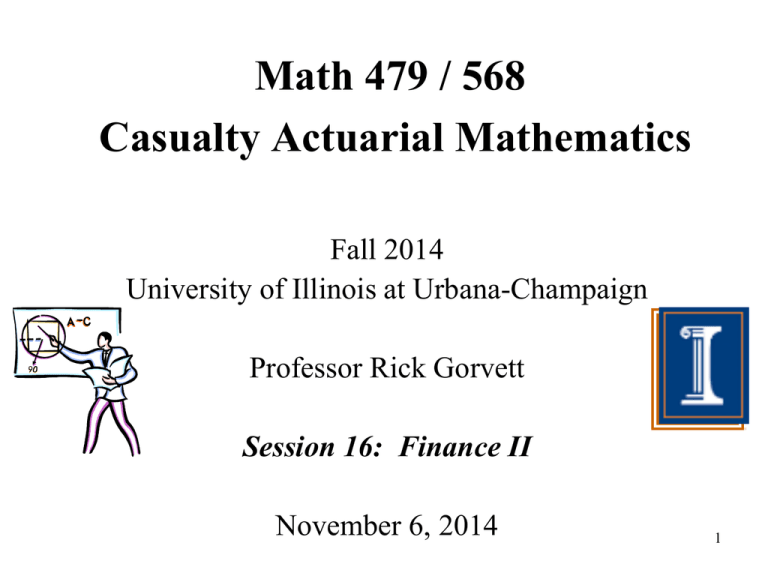
Math 479 / 568
Casualty Actuarial Mathematics
Fall 2014
University of Illinois at Urbana-Champaign
Professor Rick Gorvett
Session 16: Finance II
November 6, 2014
1
Agenda
• Option pricing theory
• Asset-liability management
• Modeling financial and economic variables
2
Quick Review of Options
C = Max [S - X, 0]
C = Call option value at expiration
S = Price of underlying asset
X = Exercise price
P = Max [X - S, 0]
P = Put option value at expiration
3
Option Values: Payoff Charts
• Call -- long position:
Payoff
ST
X
• Call -- short position:
X
• Put -- long position:
• Put -- short position:
X
X
ST
ST
ST
4
Payoff vs. Profit/Loss:
Long a Call Option
Payoff
Profit/Loss
ST
Call
Premium
X
5
Diffusion Processes
Stochastic process with continuous paths
• Brown (1827) described and named
Brownian method
• Bachelier (1900) applied to French stock
prices
• Einstein (1905) developed mathematics of
Brownian motion
• Lundberg (1909) applied Brownian motion
to collective risk theory in insurance
• Wiener (1923) refined mathematics of
Brownian motion
6
Black-Scholes
Option Pricing Model
Assumptions:
1. European option
2. No taxes or transaction costs
3. Borrowing rate = Lending rate
4. No dividends
5. Asset price follows geometric Brownian
motion
6. Markets are open continuously
7. No short sale restrictions
7
Black-Scholes
Option Pricing Model
Variables required:
1.
2.
3.
4.
5.
Underlying stock price
Exercise price
Time to expiration
Volatility of stock price
Risk-free interest rate
8
Black-Scholes Formula
VC = S N(d1) - X e-rt N(d2)
where
d1 = [ln(S/X)+(r+0.5s2)t] / st0.5
d2 = d1 - st0.5
where N( ) = cumulative normal distribution,
S = stock price,
X = exercise price,
r = continuously compounded risk-free interest rate,
t = number of periods until exercise date, and
s = std. dev. per period of continuously
compounded rate of return on the stock
Call Option Example
S = 100
X = 110
r = 0.10
T = 1.00 (year)
s = 0.25
d1 = [ln(100/110)+ (.10+(.252/2))] / (.25 11/2)
= 0.1438
d2 = .1438 - ((.25)( 11/2)
= -0.1062
Call Option Value
C = SN(d1) - Xe-rTN(d2)
C = (100 x .5572) - (110 e- .10 x 1 x .4577)
C = 10.16
• Implied Volatility
– Using Black-Scholes and the actual price of the
option, one can solve for the volatility
Another Example
Use the Black-Scholes Option Pricing Model to
calculate the value of a call option with:
Stock price = $18
Exercise price = $20
Time to expiration = 1 year
Standard deviation of stock price = .20
Risk-free rate = 5% per year
12
Answer*
d1 = (ln(18/20) + (.05+.5(.2)2)1)/(.2(1).5)
= -.1768
d2 = -.1768 - .2 (1).5
= -.3768
C = 18(N(-.1768))-20e-.05(1)(N(-.3768))
= 18(.4298)-20(.9512)(.3532)
= $1.02
13
Applying The Option Pricing
Model To Insurance*
Use option pricing to determine the value of each
claim on an insurer’s assets
Policyholders’ Claim = H
Government’s Tax Claim = T
Owners’ Claim = V
* Neil Doherty and James Garven, 1986, “Price Regulation in PropertyLiability Insurance: A Contingent Claims Approach,” Journal of Finance,
December
14
Option Pricing Model
Applied to Insurance
Stockholder
Value
Taxes
0
Liabilities
Beg. Assets
Terminal Asset Value
15
Let:
S0
P
Y0
R
k
Y1
L
t
i
=
=
=
=
=
=
=
=
=
=
Initial equity
Premiums (net of expenses)
Initial assets = S0 + P
Investment rate
Funds generating coefficient
Ending assets
S0 + P + (S0 + kP)R
Losses
Tax rate
Portion of investment income that is taxable
16
Value Of Various Claims At The
End Of The Period
• Policyholders’ claim
H1 = MAX{MIN[L,Y1],0}
• Government’s tax claim
T1 = MAX{t[i(Y1-Y0)+P-L],0}
• Owners’ claim
V e = Y 1 - H 1 - T1
17
Determine The Value Of These Claims
At The Beginning Of The Period
V(Y1)
=
Market value of asset portfolio
C[A;B]
=
Value of call option with exercise price
of B on asset with value of A
E(L)
=
Expected losses
H0
=
V(Y1) - C[Y0;E(L)]
T0
=
tC[i(Y1 - Y0) + P0;E(L)]
Ve
=
V(Y1) - H0 - T0
=
C[Y0;E(L)] - tC[i(Y1 - Y0) + P0;E(L)]
18
Example
Initial equity
Premiums written
Expenses
Net premiums
Expected losses
s of investment returns
s of losses
Risk-free interest rate
k (FGC)
i
t
Y1 = 100+160+(100+1.0(160)).04 =
100
200
40
160
150
0.5
0.0
4.0%
1.0
1.0
.34
270.4
19
Calculation Of Values
Owners’ Value Without Taxes
C[Y0;E(L)]= C[100+200-40;150]
= C[260;150]
d1 =
2)1
ln( 260
)
+
(.04
+
.5
(.5)
150
.5 (1).5
d1 = 1.43
d2 = 1.43 - .5(1).5
d2 = .93
20
Calculation Of Values (cont.)
Owners’ Value Without Taxes (cont.)
• C = 260 N(1.43) - 150e-.04(1) N(.93)
• C = 260(.9236) - 150 (.9608) (.8238)
• C [Y0;E(L)] = 121.41
21
Calculation of Values (cont.)
Government’s Claim
T0 = tC[i(Y1 - Y0) + P0;E(L)]
= .34 C[1(270.4 - 260) + 160;150]
= .34 C[170.4;150]
d1 =
170.4
ln(
) + (.04 + .5 (.5)2)1
150
.5(1).5
d1 = .5850
d2 = .5850 - .5(1).5
d2 = .0850
22
Calculation of Values (cont.)
Government’s Claim (cont.)
• C = 170.4N(.585) - 150e-.04(1) N(.085)
• C = 170.4(.7207) - 150 (.9608) (.5339)
• C[i(Y1 - Y0) + P0;E(L)] = 45.86
• T0 = .34 C[i(Y1 - Y0) + P0;E(L)] = 15.59
23
Valuing Owners’ Claim
Ve = V(Y1) - H0 - T0
= C[Y0;E(L)] - tC[i(Y1 - Y0) + P0;E(L)]
Ve = 121.41 - 15.59 = 105.82
This firm has an initial equity of $100, but
increases the firm value to $105.82 by writing
this coverage.
24
Asset-Liability Management (ALM)
• Changes in assets and liabilities may have
leveraged effects on net worth (surplus)
• ALM can help meet company to fulfill its
objectives by protecting against
intermediation risk -- e.g.,
–
–
–
–
Interest rate
Currency
Credit
Liquidity
• ALM can also help enhance returns
25
ALM for Insurers
• Insurer ALM tends to focus on “matching”
the interest rate sensitivities (i.e., durations) of
assets and liabilities
• If this can be accomplished, it is claimed that
the surplus of the insurer will be unaffected in
the event of interest rate changes
• Other sources of risk also need to be
considered
26
Duration of Surplus
• Sensitivity of an insurer’s surplus to
changes in interest rates
D S S = DA A - D L L
DS = (DA - DL)(A/S) + DL
where
D = duration
S = surplus
A = assets
L = liabilities
Surplus Duration and
Asset-Liability Management
• To “immunize” surplus from interest rate risk,
set DS = 0
• Then, asset duration should be:
DA = DL L / A
• Thus, an accurate estimate of the duration of
liabilities is critical for ALM
Economic Series Project
• CAS/SOA Request for Proposals on “Modeling of
Economic Series Coordinated with Interest Rate
Scenarios”
– A key aspect of dynamic financial analysis
– Also important for regulatory, rating agency, and internal
management tests – e.g., cash flow testing
• Goal: to provide actuaries with a model for
projecting economic and financial indices, with
realistic interdependencies among the variables.
– Provides a floor or foundation for future efforts
29
Scope of Project
• Literature review
– From finance, economics, and actuarial science
• Financial scenario model
– Generate scenarios over a 50-year time horizon
• Document and facilitate use of model
– Report includes sections on data & approach,
results of simulations, user’s guide
– To be posted on CAS & SOA websites
– Writing of papers for journal publication
30
Economic Series Modeled
• Inflation
• Real interest rates
• Nominal interest
rates
• Equity returns
• Equity dividend
yields
• Real estate returns
• Unemployment
– Large stocks
– Small stocks
31
Inflation(q)
• Modeled as an Ornstein-Uhlenbeck process
– One-factor, mean-reverting
dqt = kq (mq – qt) dt + sq dBq
– In discrete format, an autoregressive process
• Parametrization
– Annual regressions on AR process
– Two time periods: (i) since 1913; (ii) since 1946
– Base case
• Speed of reversion:
• Mean reversion level:
• Volatility:
kq = 0.40
mq = 4.8%
sq = 0.04
32
Real Interest Rates
• Two-factor Vasicek term structure model
• Short-term rate (r) and long-term mean (l)
are both stochastic variables
drt = kr (lt – rt) dt + sr dBr
dlt = kl (ml – rt) dt + sl dBl
33
Nominal Interest Rates
• Combines inflation and real interest rates
i = {(1+q) x (1+r)} - 1
where
i = nominal interest rate
q = inflation
r = real interest rate
34
Equity Returns
• Model equity returns (st) as an excess return
over the nominal interest rate
st = q t + r t + x t
• Empirical “fat tails” issue regarding equity
returns distribution
• Thus, modeled using a “regime switching
model”
– Low volatility regime
– High volatility regime
35
Equities: Excess Monthly Return
Parameters
Large Stocks (1871-2002)
Small Stocks (1926-1999)
Low Volatility
Regime
High Volatility
Regime
Low Volatility
Regime
High Volatility
Regime
0.8%
-1.1%
1.0%
0.3%
Variance
3.9%
11.3%
5.2%
16.6%
Probability of
Switching
1.1%
5.9%
2.4%
10.0%
Mean
36
